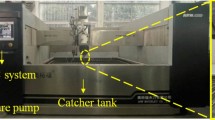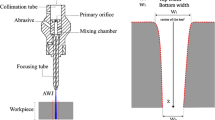Abstract
Abrasive waterjet cutting is a novel machining process capable of processing wide range of hard-to-cut materials. Surface roughness of machined parts is one of the major machining characteristics that play an important role in determining the quality of engineering components. This paper shows the influence of process parameters on surface roughness (R a) which is an important cutting performance measure in abrasive waterjet cutting of aluminium. Taguchi’s design of experiments was carried out in order to collect surface roughness values. Experiments were conducted in varying water pressure, nozzle traverse speed, abrasive mass flow rate and standoff distance for cutting aluminium using abrasive waterjet cutting process. The effects of these parameters on surface roughness have been studied based on the experimental results.
Similar content being viewed by others
References
Hascalik A, Caydas U, Gurun H. Effect of traverse speed on abrasive waterjet machining of Ti-6Al-4V alloy. Materials & Design, 2007, 28: 1953–1957
Momber A, Kovacevic R. Principles of Abrasive Waterjet Machining. London: Springer-Verlag, 1998
Hashish M. A model for abrasive waterjet (AWJ) machining. Transactions of ASME Journal of Engineering Materials and Technology, 1989, 111(2): 154–162
Siores E, Wong W C K, Chen L, Wager J G. Enhancing abrasive waterjet cutting of ceramics by head oscillation techniques. Ann CIRP, 1996, 45(1): 215–218
Wang J. Abrasive Waterjet Machining of Engineering Materials. Uetikon-Zuerich: Trans Tech Publications, 2003
Azmir M A, Ahsan A K. Investigation on glass/epoxy composite surfaces machined by abrasive waterjet machining. Journal of Materials Processing Technology, 2008, 198(1–3): 122–128
Ma C, Deam R T. A correlation for predicting the kerf profile from abrasive waterjet cutting. Experimental Thermal and Fluid Science, 2006, 30(4): 337–343
Kovacevic R. Monitoring the depth of abrasive waterjet penetration. International Journal of Machine Tools & Manufacture, 1992, 32(5): 725–736
Hashish M. Optimization factors in abrasive waterjet machining. Transactions of the ASME: Journal of Engineering for Industry, 1991, 113: 29–37
Rozario Jegaraj J J, Ramesh Babu N. A soft computing approach for controlling the quality of cut with abrasive waterjet cutting system experiencing orifice and focusing tube wear. Journal of Materials Processing Technology, 2007, 185(1–3): 217–227
Shanmugam D K, Wang J, Liu H. Minimization of kerf tapers in abrasive waterjet machining of alumina ceramics using a compensation technique. International Journal of Machine Tools & Manufacture, 2008, 48(14): 1527–1534
Shanmugam D K, Masood S H. An investigation of kerf characteristics in abrasive waterjet cutting of layered composites. International Journal of Material Processing Technology, 2009, 209(8): 3887–3893
Lemma E, Chen L, Siores E, Wang J. Optimising the AWJ cutting process of ductile materials using nozzle oscillation technique. International Journal of Machine Tools & Manufacture, 2002, 42(7): 781–789
Wang J. Predictive depth of jet penetration models for abrasive waterjet cutting of alumina ceramics. International Journal of Mechanical Sciences, 2007, 49(3): 306–316
Farhad K, Hamid K A. A statistical approach for predicting and optimizing depth of cut in AWJ machining for 6063-T6 Al alloy. World Academy of Science, Engineering and Technology, 2009, 59
Chithirai Pon Selvan M, Mohana Sundara Raju N. Selection of process parameters in abrasive waterjet cutting of copper. International Journal of Advanced Engineering Sciences and Technologies, 2011, 7(2): 254–257
Arola D, Ramulu M. A study of kerf characteristics in abrasive waterjet machining of graphite/epoxy composites. Journal of Engineering Materials and Technology, 1993, 45(66): 125–151
Wang J, Wong W C K. A study of abrasive waterjet cutting of metallic coated sheet steels. International Journal of Machine Tools & Manufacture, 1999, 39(6): 855–870
Hocheng H, Tsai H Y, Shiue J J, Wang B. Feasibility study of abrasive waterjet milling of fiber-reinforced plastics. Journal of Manufacturing Science and Engineering, 1997, 119: 133–142
Author information
Authors and Affiliations
Corresponding author
Rights and permissions
About this article
Cite this article
Chithirai Pon Selvan, M., Mohana Sundara Raju, N. & Sachidananda, H.K. Effects of process parameters on surface roughness in abrasive waterjet cutting of aluminium. Front. Mech. Eng. 7, 439–444 (2012). https://doi.org/10.1007/s11465-012-0337-0
Received:
Accepted:
Published:
Issue Date:
DOI: https://doi.org/10.1007/s11465-012-0337-0




